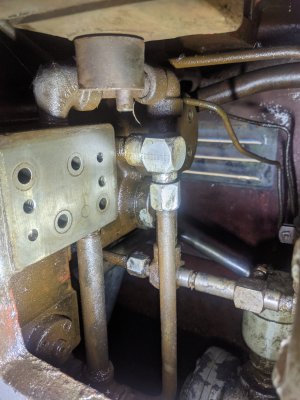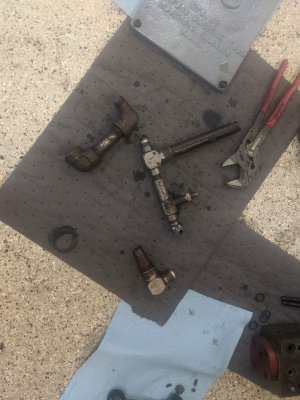- Joined
- Aug 3, 2017
- Messages
- 2,437
So I recently got a hydraulic shaper and I'm trying to get it back to tip top shape. I noticed it is taking a bit to build up pressure, so I pulled the side off and noticed it is leaking quite a bit at the angle coming out of the block here(top left):
This required quite a bit of careful disassembly to get out, but I eventually did. It says cat40 on the side of these pipes.
Getting this back together is likely going to be a bear, so I was hoping someone could give some advice. The biggest problem is that I have to install the "near" 90 alone, overtighten it (so there is clearance to tighten the straight/other 90), then "loosen" the 1st 90 to get the pipes lined up right.
I presume this is why it was leaking as much as it was at that junction.
So I guess my questions are:
1: is there a trick to doing this? Is there some expanding, slow drying goop you put on the pipe threads that wouldn't let it leak?
2: could I be better to replace them with a different type of fitting? Perhaps a flexible hose of some sort? I have a pipe thread on both sides ( see the balck pipe on the other hose), but perhaps I could use AN fittings and some braided line for this instead?
Any other thoughts to make this an easier assembly?


This required quite a bit of careful disassembly to get out, but I eventually did. It says cat40 on the side of these pipes.
Getting this back together is likely going to be a bear, so I was hoping someone could give some advice. The biggest problem is that I have to install the "near" 90 alone, overtighten it (so there is clearance to tighten the straight/other 90), then "loosen" the 1st 90 to get the pipes lined up right.
I presume this is why it was leaking as much as it was at that junction.
So I guess my questions are:
1: is there a trick to doing this? Is there some expanding, slow drying goop you put on the pipe threads that wouldn't let it leak?
2: could I be better to replace them with a different type of fitting? Perhaps a flexible hose of some sort? I have a pipe thread on both sides ( see the balck pipe on the other hose), but perhaps I could use AN fittings and some braided line for this instead?
Any other thoughts to make this an easier assembly?



